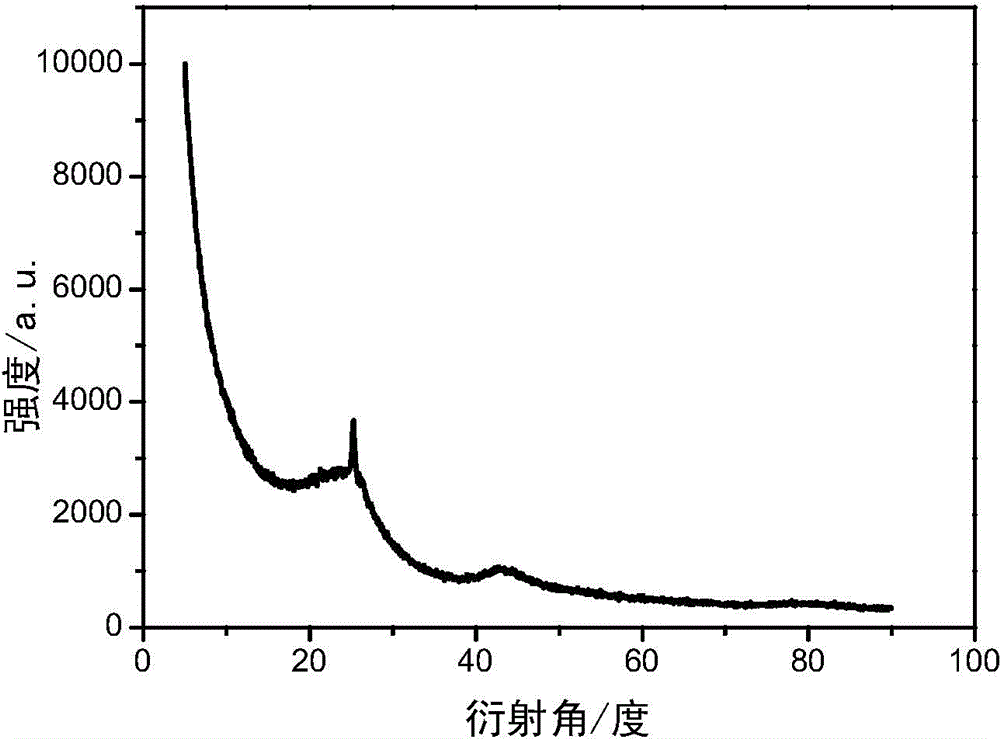High-magnification active carbon and active graphene composite electrode material and preparation method thereof
A graphene composite and electrode material technology, which is applied in the directions of hybrid capacitor electrodes and hybrid/electric double layer capacitor manufacturing, etc., can solve the problems of serious environmental pollution, long time consumption, and difficulty in ensuring uniform dispersion of graphene, and achieves a simple process, The effect of improving the magnification performance
- Summary
- Abstract
- Description
- Claims
- Application Information
AI Technical Summary
Problems solved by technology
Method used
Image
Examples
Embodiment 1
[0028] Evenly disperse 0.3681g of 325 mesh graphite powder and 0.184g of sodium nitrate powder into 9.57ml of concentrated sulfuric acid solution, and stir for 2h to obtain a uniformly dispersed mixture solution. Note that this process should be carried out in an ice bath or ice-water bath to prevent the temperature of the mixture from becoming too high. Slowly add 1.1 g of potassium permanganate powder to the sulfuric acid solution uniformly dispersed with graphite powder and sodium nitrate powder to form a suspension, and then add 17.68 ml of deionized water to the above suspension. The suspension was heated to undergo high-temperature reaction stages of 35°C and 98°C, and finally graphite oxide was obtained. It is not necessary to separate the obtained graphite oxide from the reaction system, but directly add it to a 250ml beaker, measure 100ml of distilled water into it with a graduated cylinder, and then ultrasonicate it for 8 hours to obtain a graphene oxide dispersion, ...
Embodiment 2
[0031] Add the graphite oxide prepared in Example 1 into a 250ml beaker, measure 100ml of distilled water with a measuring cylinder and pour it into it, then ultrasonicate it for 8h to obtain a graphene oxide dispersion, and then add 8.645g of the graphene oxide dispersion to the graphene oxide dispersion Activated carbon is mixed, and after stirring evenly, the mixed solution is dried. The dried product was heated to 400° C. for reduction activation under nitrogen atmosphere, and kept for 6 hours. After cooling, the obtained primary product was washed (pH=6-7), filtered, and dried to obtain the final product.
[0032] The above-mentioned final products were dried in a blast drying oven at 100° C. and stored for electrochemical performance testing. The composite material is mixed according to the ratio of active material: conductive agent: binder = 85:10:5 to make electrode sheet, then carry out cyclic voltammetry test in 6MKOH electrolyte, test result is as follows Image 6 ...
Embodiment 3
[0034] The graphite oxide prepared in Example 1 was added to a 250ml beaker, and 100ml of distilled water was poured into it with a measuring cylinder, and then ultrasonicated for 8h to obtain a graphene oxide dispersion, and then 4.095g of the graphene oxide dispersion was added to the graphene oxide dispersion. Activated carbon is mixed, and after stirring evenly, the mixed solution is dried. The dried product was heated to 400° C. for reduction activation under nitrogen atmosphere, and kept for 6 hours. After cooling, the obtained primary product was washed (pH=6-7), filtered, and dried to obtain the final product.
[0035] The above-mentioned final products were dried in a blast drying oven at 100° C. and stored for electrochemical performance testing. The composite material is mixed according to the ratio of active material: conductive agent: binder = 85:10:5 to make an electrode sheet, and then carry out a constant current charge and discharge test in a 6MKOH electrolyte...
PUM
| Property | Measurement | Unit |
|---|---|---|
| electrical resistivity | aaaaa | aaaaa |
Abstract
Description
Claims
Application Information
 Login to View More
Login to View More - R&D
- Intellectual Property
- Life Sciences
- Materials
- Tech Scout
- Unparalleled Data Quality
- Higher Quality Content
- 60% Fewer Hallucinations
Browse by: Latest US Patents, China's latest patents, Technical Efficacy Thesaurus, Application Domain, Technology Topic, Popular Technical Reports.
© 2025 PatSnap. All rights reserved.Legal|Privacy policy|Modern Slavery Act Transparency Statement|Sitemap|About US| Contact US: help@patsnap.com



